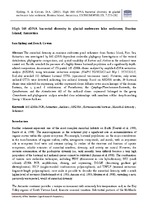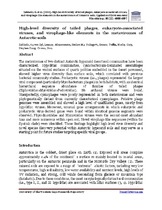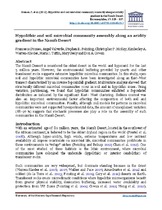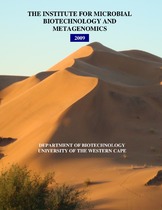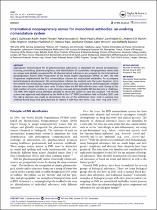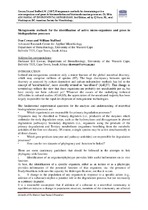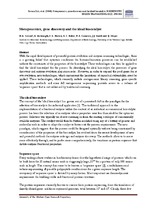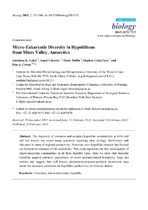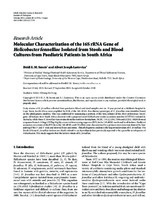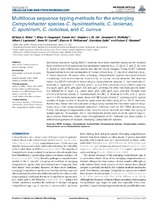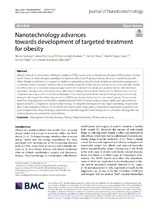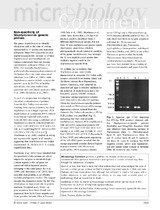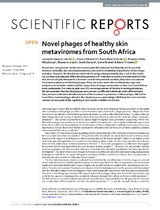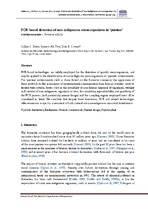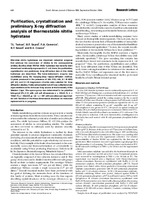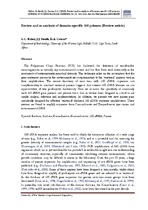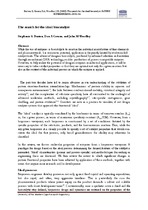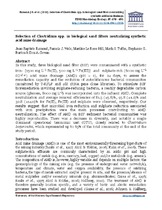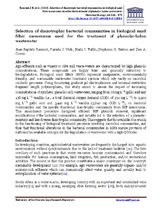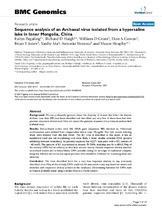Browsing Institute for Microbial Biotechnology & Metagenomics by Title
Now showing items 13-32 of 37
-
High 16S rDNA bacterial diversity in glacial meltwater lake sediment, Bratina Island, Antarctica
(Springer Verlag, 2003)The microbial diversity in maritime meltwater pond sediments from Bratina Island, Ross Sea, Antarctica was investigated by 16S rDNA-dependent molecular phylogeny. Investigations of the vertical distribution, phylogenetic ... -
High-level diversity of tailed phages, eukaryote-associated viruses, and virophage-like elements in the metaviromes of Antarctic soils
(American Society for Microbiology, 2014)The metaviromes of two distinct Antarctic hyperarid desert soil communities have been characterized. Hypolithic communities, cyanobacterium-dominated assemblages situated on the ventral surfaces of quartz pebbles embedded ... -
Hypolithic and soil microbial community assembly along an aridity gradient in the Namib Desert
(Springer, 2013)The Namib Dessert is considered the oldest desert in the world and hyperarid for the last 5 million years. However, the environmental buffering provided by quartz and other translucent rocks supports extensive hypolithic ... -
The Institute for Microbial Biotechnology and Metagenomics 2009
(UWC, 2010-01)The IMBM Brochure (2009) provides a summary of the staffing, activities and outputs of the Institute for the 2009 academic year -
International nonproprietary names for monoclonal antibodies: an evolving nomenclature system
(Taylor and Francis, 2022)Appropriate nomenclature for all pharmaceutical substances is important for clinical development, licensing, prescribing, pharmacovigilance, and identification of counterfeits. Nonproprietary names that are unique and ... -
Metagenomics, gene discovery and the ideal biocatalyst
(Portland Press, 2004)With the rapid development of powerful protein evolution and enzyme-screening technologies, there is a growing belief that optimum conditions for biotransformation processes can be established without the constraints of ... -
Micro-Eukaryotic diversity in Hypolithons from Miers Valley, Antarctica
(Multidisciplinary Digital Publishing Institute (MDPI), 2013)The discovery of extensive and complex hypolithic communities in both cold and hot deserts has raised many questions regarding their ecology, biodiversity and relevance in terms of regional productivity. However, most ... -
Molecular characterization of the 16S rRNA Gene of helicobacter fennelliae isolated from stools and blood cultures from paediatric patients in South Africa
(Hindawi, 2011)Forty strains of H. fennelliae collected from paediatric blood and stool samples over an 18 year period at a children's hospital in Cape Town, South Africa, were amplified by PCR of the 16S rRNA. Two distinct genotypes ... -
Multilocus sequence typing methods for the emerging Campylobacter species C. hyointestinalis, C. lanienae, C. sputorum, C. concisus, and C. curvus
(Frontiers Media, 2012)Multilocus sequence typing (MLST) systems have been reported previously for multiple food - and food animal-associated Campylobacter species (e.g., C. jejuni, C. coli, C. lari, and C. fetus) to both differentiate strains ... -
Nanotechnology advances towards development of targeted-treatment for obesity
(Journal of Nanobiotechnology, 2019)Obesity through its association with type 2 diabetes (T2D), cancer and cardiovascular diseases (CVDs), poses a serious health threat, as these diseases contribute to high mortality rates. Pharmacotherapy alone or in ... -
Non-specificity of Staphylococcus generic primers
(Society for General Microbiology, 2003)Our results allow us to conclude that there appears to be significant conservation between the tuf genes of Planococcus, Planomicrobium and Staphylococcus spp., and that although the primer set TstaG422/TStag765 has ... -
Novel phages of healthy skin metaviromes from South Africa
(Nature Publishing Group, 2018)Recent skin metagenomic studies have investigated the harbored viral diversity and its possible influence on healthy skin microbial populations, and tried to establish global patterns of skin-phage evolution. However, ... -
PCR-based detection of non-indigenous microorganisms in ‘pristine’ environments
(Elsevier, 2003)PCR-based technologies are widely employed for the detection of specific microorganisms, and may be applied to the identification of non-indigenous microorganisms in ‘pristine’ environments. For ‘pristine’ environments ... -
Purification, crystallization and preliminary X-ray diffraction analysis of thermostable nitrile hydratase: research letter
(Academy of Science of South Africa (ASSAf), 2004)Microbial nitrile hydratases are important industrial enzymes that catalyse the conversion of nitriles to the corresponding amides. Bacillus strain RAPc8 nitrile hydratase has recently been cloned and functionally ... -
Review and re-analysis of domain-specific 16S primers
(Elsevier, 2003)The Polymerase Chain Reaction (PCR) has facilitated the detection of unculturable microorganisms in virtually any environmental source and has thus been used extensively in the assessment of environmental microbial diversity. ... -
The search for the ideal biocatalyst
(Nature Publishing Group, 2002)While the use of enzymes as biocatalysts to assist in the industrial manufacture of fine chemicals and pharmaceuticals has enormous potential, application is frequently limited by evolution-led catalyst traits. The advent ... -
Selection of Clostridium spp. in biological sand filters neutralizing synthetic acid mine drainage
(Wiley, 2013)In this study, three biological sand filter (BSF) were contaminated with a synthetic iron- [1500 mg L-1 Fe(II), 500 mg L-1 Fe(III)] and sulphate-rich (6000 mg L-1 SO2/4-) acid mine drainage (AMD) (pH = 2), for 24 days, to ... -
Selection of diazotrophic bacterial communities in biological sand filter mesocosms used for the treatment of phenolic-laden wastewater
(Springer Verlag, 2013)Agri effluents such as winery or olive mill waste-waters are characterized by high phenolic concentrations. These compounds are highly toxic and generally refractory to biodegradation. Biological sand filters (BSFs) represent ... -
Sequence analysis of an Archaeal virus isolated from a hypersaline lake in Inner Mongolia, China
(BioMed Central, 2007)Background: We are profoundly ignorant about the diversity of viruses that infect the domain Archaea. Less than 100 have been identified and described and very few of these have had their genomic sequences determined. ...

